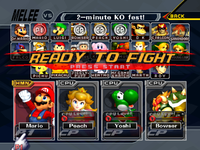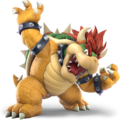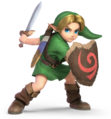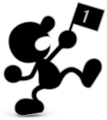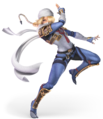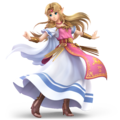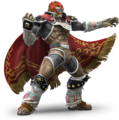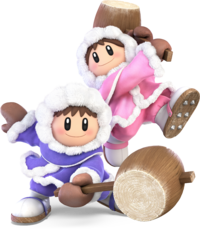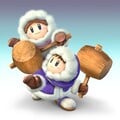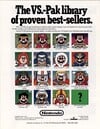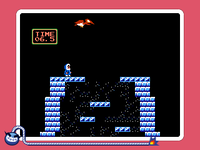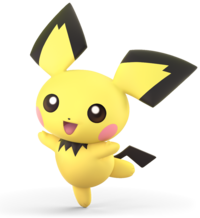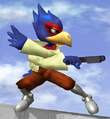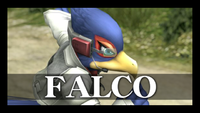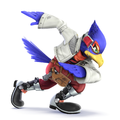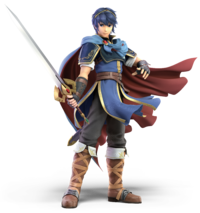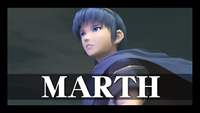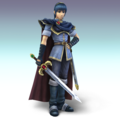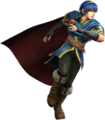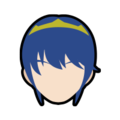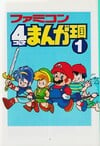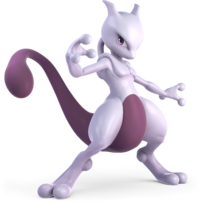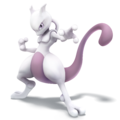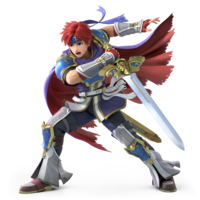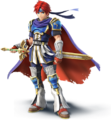List of fighters debuting in Super Smash Bros. Melee
This is a list of Super Smash Bros. series fighters that debuted in Super Smash Bros. Melee. The page details their role in this series as well as other Super Mario-related media. Super Mario characters, as well as characters not originally from the Super Mario franchise who have had at least one significant appearance in bona fide Super Mario media, are covered in detail on their own articles.
See also:
- List of fighters debuting in Super Smash Bros.
- List of fighters debuting in Super Smash Bros. Brawl
- List of fighters debuting in Super Smash Bros. for Nintendo 3DS and Super Smash Bros. for Wii U
- List of fighters debuting in Super Smash Bros. Ultimate
Fighters with articles[edit]
Fighters covered in crossover articles[edit]
Ice Climbers[edit]
- SmashWiki article: Ice Climbers
- This section is about the recurring duo in the Super Smash Bros. series. For the WarioWare: D.I.Y. microgame, see Ice Climbers (microgame).
- "Ice Climber" redirects here. For the microgame from WarioWare, Inc.: Mega Microgame$!, see Ice Climber (WarioWare, Inc.: Mega Microgame$!). For the microgame from WarioWare: Twisted!, see Ice Climber (WarioWare: Twisted!).
- “In Ice Climber, Popo and Nana are identical outside of their clothing. Two players can play at the same time, and the game can be cooperative or competitive depending on how you play.”
- —Tips, Super Smash Bros. Ultimate
The Ice Climbers, named Ice Climber in Japan, are a pair consisting of a boy named Popo and a girl named Nana, who originate from the NES game Ice Climber. Though they have had only one single game of their own, aside from the modified VS. UniSystem arcade conversion VS. Ice Climber, they have made frequent crossover appearances in other Nintendo games, including Game & Watch Gallery 4, WarioWare: Twisted!, WarioWare: Touched!, Tetris DS, a mention in Game & Watch Gallery 3, and another appearance in NES Remix. Both Ice Climbers are playable fighters in Super Smash Bros. Melee, Super Smash Bros. Brawl, and Super Smash Bros. Ultimate.
Super Smash Bros. series[edit]
Super Smash Bros. Melee[edit]
- SmashWiki article: Ice Climbers (SSBM)
The Ice Climbers appear as a new, playable default character in Super Smash Bros. Melee. The two are unique, as they fight as a team, but act as two separate characters. Depending on the alternate costume, the player can control either Popo or Nana, while the other is a computer player that copies their inputs and returns to the player when they are separated. The Ice Climbers attack simultaneously, and as they are two characters the player can grab two opponents and hold two items at once. If the second climber is KO'd, the leading one can still fight, but their attacks are not as powerful as they would be if both are present. However, if the player-controlled climber is KO'd, they are both sent back to the respawn platform. Also unique to the Ice Climbers is that they have normal traction on slippery ground.
Their neutral special move is Ice Shot, which sends out icicles toward the opponents. Their side special is Squall Hammer, in which the climbers spin around with their hammers. Their down special move is Blizzard, which has Popo and Nana send out a blast of cold air, briefly freezing an opponent if the opponent has high enough damage. Their up special move is Belay, in which one of the climbers throws the others into the air with a rope to pull the other up while damaging anyone who gets in the way of the attack; both Ice Climbers are put into a helpless state once the move finishes.
Both Popo and Nana are voiced by Sanae Kobayashi.
Gallery[edit]
Super Smash Bros. Brawl[edit]
- SmashWiki article: Ice Climbers (SSBB)
The Ice Climbers return to the series in Super Smash Bros. Brawl, retaining their moveset and attributes from Super Smash Bros. Melee. However, both Ice Climbers are able to grab a ledge at the same time; in the previous game, the other climber cannot grab on if one is already on the ledge. Their Final Smash is Iceberg, in which they create a large iceberg in the middle of the stage; it freezes any platform in the surrounding area and damages any opposing player who touches the iceberg, doing a heavy amount of damage and sometimes freezing them. Players can attack the iceberg to shrink it, though the iceberg shrinks completely after a period of time.
The Subspace Emissary[edit]
The Ice Climbers were first seen climbing up the Glacial Peak, completely oblivious to the shootout between the Great Fox and the Battleship Halberd. However, they do see Meta Knight climbing past them, trying to get to the Halberd. The Ice Climbers see this as a challenge, and race him to the top, managing to reach it first. However, they discover the Aura Pokémon Lucario up there, who challenges Meta Knight. Popo and Nana could only watch. Just after the battle, the Halberd rams the Great Fox into the mountain. While Meta Knight and Lucario take this chance to get inside the Halberd, the Ice Climbers fall into the Canyon, where they find themselves with Marth, Lucas, the Pokémon Trainer, and Ike. The Subspace Army attacks them all, but they are saved by Mario, Link, Yoshi, Kirby, and Pit. The Ice Climbers eventually go to Subspace with all of the heroes, where they all get turned into trophies by Tabuu. However, Kirby is then revived by a badge created by King Dedede, so he saves Popo and Nana along with some other characters. The entire team then goes after Tabuu.
Gallery[edit]
Link gets frozen by Blizzard
Super Smash Bros. for Nintendo 3DS / Super Smash Bros. for Wii U[edit]
The Ice Climbers do not return as playable characters in Super Smash Bros. for Nintendo 3DS and Super Smash Bros. for Wii U, making them the only playable characters in the entire series that have been playable in more than one game before being cut. The director of the games, Masahiro Sakurai, has stated this is because they were unable to run smoothly on the Nintendo 3DS version of the game, and that while the Ice Climbers were running perfectly in the Wii U version, they were cut as they were unlikely to get a new game and Sakurai didn’t want the Wii U version to have an exclusive character. Instead, they appear as a trophy in both versions of the game; the trophy is a random unlockable in Super Smash Bros. for Nintendo 3DS; to unlock the trophy in Super Smash Bros. for Wii U, the player has to KO his/her rival four times in a single Rival Smash match.
Icicle Mountain's theme from Super Smash Bros. Melee and Ice Climbers' theme from Super Smash Bros. Brawl returns in the Wii U version as alternate themes for the Wrecking Crew stage, despite the characters being cut.
On a side note, the Polar Bears from their series appear as enemies in the 3DS-exclusive game mode, Smash Run.
Super Smash Bros. Ultimate[edit]
- SmashWiki article: Ice Climbers (SSBU)
The Ice Climbers, alongside all Super Smash Bros. series veterans, return as unlockable playable fighters in Super Smash Bros. Ultimate. They received many aesthetic changes, such as Nana being more expressive when Popo grabs an opponent, or vice-versa. The Ice Climbers also have 8 costumes, like all other characters in the game. On a side note, the Ice Climbers' victory theme has been shortened compared to Super Smash Bros. Brawl.
The Ice Climbers retain their Final Smash from Super Smash Bros. Brawl, though it functions slightly differently: the iceberg now revolves, and no longer freezes opponents, instead only damaging them.
Both Popo and Nana's fighter spirit uses their artwork from Ice Climber.
Classic Mode route[edit]
| Duos for Days | ||||
|---|---|---|---|---|
| Round | Opponent(s) | Stage | Song | |
| 1 | Link, Zelda | Great Plateau Tower | Main Theme - The Legend of Zelda: Breath of the Wild | |
| 2 | Ryu, Ken | Suzaku Castle | Ryu Stage | |
| 3 | Villager, Isabelle | Smashville | Title Theme - Animal Crossing: Wild World (Brawl) | |
| 4 | Donkey Kong, Diddy Kong | Jungle Japes | Jungle Level (Melee) | |
| 5 | Palutena, Pit | Palutena's Temple | Title Theme - Kid Icarus | |
| 6 | Mario, Peach | Princess Peach's Castle | Main Theme - New Super Mario Bros. | |
| Final | Master Hand, Crazy Hand | Final Destination | Master Hand / Crazy Hand | |
Gallery[edit]
[edit]
VS. System flyer[edit]
In a flyer advertising a number of games for the VS. System, Mario wears the outfits of characters that appear in each of them. One of them shows him wearing a red Ice Climber outfit.
WarioWare series[edit]
Popo makes a number of appearances in the WarioWare series in microgames based on Ice Climber. The player controls Popo in the Ice Climber microgame in WarioWare, Inc.: Mega Microgame$! and WarioWare Gold, the Ice Climber microgame in WarioWare: Twisted!, and the Ice Climbers microgame in WarioWare: D.I.Y. In WarioWare: Touched!, Popo appears as the sprite in the third level of 8-Bit Hero. In WarioWare: Get It Together!, he makes a cameo in the Ice Climber microgame, where he is seen hanging onto the condor.
Super Mario Maker[edit]
The Ice Climbers appear as one of the add-on Mystery Mushroom costumes that are unlocked after completing an Event Course titled "Popo & Nana's Climbing Challenge" in Super Mario Maker. Their animations and sound effects are taken directly from their original game.
Audio samples[edit]
| File info |
| File info |
Names in other languages[edit]
Ice Climbers[edit]
| Language | Name | Meaning | Notes |
|---|---|---|---|
| Japanese | アイスクライマー[?] Aisu Kuraimā |
Ice Climber | |
| Chinese | 雪人兄弟[?] Xuěrén Xiōngdì |
Snowman Brothers | |
| 翻越冰山者[?] Fānyuè Bīngshān Zhě |
Ice Mountaineers | Super Smash Bros. Ultimate | |
| Korean | 얼음 타기[?] Eol'eum Tagi |
Ice Climbing (mistranslation of "Ice Climbers") | |
| Russian | Альпинисты[?] Al'pinisty |
Alpinists | |
| Spanish | Ice Climbers[?] | - |
Popo and Nana[edit]
| Language | Name | Meaning | Notes |
|---|---|---|---|
| Japanese | ポポとナナ[?] Popo to Nana |
Popo and Nana | |
| Chinese | 波波和娜娜[?] Bōbō hé Nànà |
Popo and Nana | |
| Dutch | Popo en Nana[?] | Popo and Nana | |
| French | Popo et Nana[?] | Popo and Nana | |
| German | Pepe und Nana[?] | Popo and Nana | |
| Korean | 포포 와 나나[?] Popo wa Nana |
Popo and Nana | |
| Russian | Попо и Нана[?] Popo i Nana |
Popo and Nana | |
| Spanish | Popo y Nana[?] | Popo and Nana |
Pichu[edit]
- Bulbapedia article: Pichu (Super Smash Bros.)
- SmashWiki article: Pichu
- “Pichu isn't a professional at charging electricity like Pikachu. The slightest touch can make Pichu discharge its electricity and shock itself.”
- —Tips, Super Smash Bros. Ultimate
Pichu is an Electric-type Pokémon introduced in the games Pokémon Gold and Pokémon Silver. It is the pre-evolved form of Pikachu, the Pokémon mascot. It appears as a playable fighter in Super Smash Bros. Melee and Super Smash Bros. Ultimate and as a trophy in Super Smash Bros. Brawl and Super Smash Bros. for Nintendo 3DS, as well as being mentioned in the Palutena's Guidance conversation regarding Pikachu in Super Smash Bros. for Wii U and Super Smash Bros. Ultimate.
Super Smash Bros. Melee[edit]
- SmashWiki article: Pichu (SSBM)
Pichu is a playable fighter in Super Smash Bros. Melee. It is an unlockable character, unlocked by beating Event Match 37: Legendary Pokémon, or by playing 200 Melee matches. Afterward, Pichu must be defeated in a match on Pokémon Stadium.
Pichu's moveset is similar to Pikachu's, though most of its attacks are weaker, and all of its electrical attacks also deal recoil damage. Pichu is also faster than Pikachu, but is the lightest character in the game, making it easily thrown off the stage. Its neutral special move is Thunder Jolt, which involves Pichu launching a ball of electricity rotating across the stage until it collides with an opponent. Its side special move is Skull Bash, which has Pichu charging up an attack before launching head-first across the screen, attacking any opponent it hits with a headbutt. Its down special move is Thunder, in which Pichu calls down a bolt of lightning that appears from a cloud above it and strikes any fighters in its path to damage them; if the bolt strikes Pichu, any nearby fighters are damaged by it as well. Finally, Pichu's up special move is Agility, allowing Pichu to warp in the direction held on the control stick in a burst of speed, and again if the direction is changed during the move; however, unlike Pikachu's Quick Attack, it neither gives as much distance nor deals damage.
Pichu is the only character in the game to have two taunts, one for each direction it is facing. It is voiced by Satomi Kōrogi in both English and Japanese, who does its voice in the Pokémon anime.
Gallery[edit]
Super Smash Bros. Brawl[edit]
Pichu is one of the five Super Smash Bros. Melee fighters that did not return as a playable character in Super Smash Bros. Brawl (the other four being Dr. Mario, Young Link, Mewtwo, and Roy). However, the player can get a trophy of Pichu by clearing All-Star Mode without continuing.
Super Smash Bros. for Nintendo 3DS / Super Smash Bros. for Wii U[edit]
Pichu appears once again as a collectible trophy in Super Smash Bros. for Nintendo 3DS, while it is referenced in Palutena's Guidance regarding Pikachu in Super Smash Bros. for Wii U.
Super Smash Bros. Ultimate[edit]
- SmashWiki article: Pichu (SSBU)
Pichu, after being absent as a playable character in every Super Smash Bros. game since Super Smash Bros. Melee, returns as an unlockable playable fighter in Super Smash Bros. Ultimate. Like all other fighters in the game, it has a Final Smash, Volt Tackle, which functions similarly to Pikachu's identically named move, although Pichu's version does recoil damage to itself, but is also stronger. Pichu gains a new on-screen appearance and two new taunts, and it vocalises during some animations.
Compared to its appearance in Super Smash Bros. Melee, Pichu is faster, its aerial attacks have less landing lag, its short hop timing is reduced, it is heavier, its moveset (in addition to being slightly more differentiated from Pikachu's) has attacks that knock opponents back farther, many of its attacks deal more damage to opponents, and it does less damage to itself with electrical attacks (said attacks now cause around 0.4% damage each as opposed to 1–6%). Some of its attacks, however, are weakened.
Pichu's fighter spirit uses its artwork from Pokémon Global Link.
Classic Mode route[edit]
| Lightweight Fracas | ||||
|---|---|---|---|---|
| Round | Opponent(s) | Rule | Stage | Song |
| 1 | Jigglypuff | Pokémon Stadium 2 | Pokémon Center - Pokémon Red / Pokémon Blue | |
| 2 | Squirtle | Peach's Castle | Road to Viridian City - Pokémon Red / Pokémon Blue | |
| 3 | Mr. Game & Watch | Skyworld | Underworld | |
| 4 | Olimar | Pilotwings | Light Plane | |
| 5 | Kirby, Meta Knight | Free-for-All | Skyloft | Butter Building (for 3DS / Wii U) |
| 6 | Mewtwo | Prism Tower | Pokémon Red / Pokémon Blue Medley | |
| Final | Master Hand, Crazy Hand (intensity 7.0 or higher) | Final Destination | Master Hand Master Hand / Crazy Hand (intensity 7.0 or higher) | |
Audio samples[edit]
| File info |
Names in other languages[edit]
| Language | Name | Meaning | Notes |
|---|---|---|---|
| Japanese | ピチュー[?] Pichū |
From「ピカピカ」(pikapika, onomatopoeia for sparkling),「チューチュー」(chūchū, onomatopoeia for squeaking mice), and「プチ」(puchi, "little") | |
| Chinese | 皮丘[?] Píqiū |
Pichu | |
| Italian | Pichu[?] | Pichu | |
| Korean | 피츄[?] Pichyu |
Pichu | |
| Russian | Пичу[?] Pichu |
Pichu | |
| Spanish | Pichu[?] | Adaptation from Pichū |
Falco[edit]
- LylatWiki article: Falco Lombardi
- SmashWiki article: Falco Lombardi
- “Personally, I prefer the air!”
- —Falco, Super Smash Bros. Brawl
Falco Lombardi is one of the main protagonists of the Star Fox series, the "ace pilot" of the team Star Fox and, due to his flying skills, the friendly rival of team leader Fox McCloud. He used to be the head of a gang, but bailed out to join the Star Fox team as Fox's second-in-command. Falco leaves the Star Fox team on occasions, and always reappears when needed. He has a very laid back but cocky attitude and is smart mouthed. Despite this, nothing gets in the way of Falco and Fox's friendship.
His surname is derived from the surname of Carlo Rambaldi, a special effects artist on films such as Alien and E.T. the Extra-Terrestrial.[1]
Super Smash Bros. series[edit]
Super Smash Bros. Melee[edit]
- SmashWiki article: Falco (SSBM)
Falco is a playable fighter in Super Smash Bros. Melee. He is, however, unlockable, and is unlocked by beating 100-Man Melee or by playing 300 Melee matches, and then beating Falco on Battlefield. While his voice clips are mostly provided by Hisao Egawa, Ben Cullum voices Falco during the Adventure Mode Stage 6 cutscene or the Corneria Smash Taunt, and would later provide Falco's voice for Star Fox Adventures.
Falco's moves are exactly the same as Fox's, though his special moves have different attributes. Falco's Blaster has more of a forceful effect but isn't rapid-fire, and his Reflector attack blasts people upwards instead of sideways. His side special, named Falco Phantasm, possesses a meteor smash effect when used in midair though it does not travel as far as Fox's Fox Illusion, and his up special, Fire Bird, does not have as much reach as Fox's Fire Fox but can deal more damage. In addition, Falco has more attack power and jumps higher than Fox, while running slower and falling faster. Falco is also heavier than Fox, though is still one of the lighter characters.
Falco also appears in Stage 6 of Adventure Mode. In this, he, Slippy, and Peppy will appear in their Arwings in the second half of the battle to shoot at both the player and Fox. Additionally, if Falco is unlocked, he will sometimes replace Fox in the second battle, forcing Fox into the Arwing.
Gallery[edit]
Super Smash Bros. Brawl[edit]
- SmashWiki article: Falco (SSBB)
Falco returns as an unlockable character in Super Smash Bros. Brawl. To unlock him, the player must to play 50 Brawl matches, complete 100-Man Brawl, or having him join the party in The Subspace Emissary after clearing The Swamp; using one of the former two methods the player must then beat him on Lylat Cruise to unlock him. His design has been changed, appearing more similarly to his appearance in Star Fox Command rather than Star Fox 64, and is now voiced by Dex Manley for the English version.
Falco's moveset has been altered for this game, differentiating him further from Fox. He kicks his Reflector forward rather than holding it in place, and his Falco Phantasm travels as far as Fox Illusion. His Final Smash is the Landmaster, in which he summons one of the vehicles to drive and attack opponents. Compared to Fox's Landmaster, this vehicle has weaker shots and battering damage, but a stronger barrel roll with less knockback, and the cannon shots deal more damage when opponents are standing on it. It also flies faster than Fox's, though it is the slowest on the ground.
Falco also has a Smash Taunt on the Lylat Cruise stage as well as on the returning Corneria stage.
The Subspace Emissary[edit]
In the Subspace Emissary, he appears after Bowser shoots Diddy Kong (and uses him and some Shadow Bugs to create False Diddy Kong) and almost shoots Fox McCloud. Falco comes in with Arwing and jumps out with his guns to shoot and destroy Bowser's Dark Cannon (causing Bowser to retreat) and sees False Diddy Kong, Fox revives Diddy Kong and they all fight the evil clone. After defeat, Falco attempts to leave but Diddy Kong tries to tells him Donkey Kong has been kidnapped and turned into a trophy. Falco however ignores him, so Diddy Kong grabs Falco and drags him, just as he did with Fox when he ignored Diddy Kong. After Falco understands, he jumps inside his Arwing so they can follow Donkey Kong. Falco drops Diddy Kong off on the plane Donkey Kong is on, and he (with Captain Olimar and Captain Falcon) rescues Donkey Kong. Falco flies by in his Arwing giving a thumbs up at Diddy Kong.
After this, he wasn't seen again until the battle at the Battleship Halberd Bridge, where he joins Fox, Peach, Zelda, Lucario, and Solid Snake in defeating Duon. Once all of the teams unite, they enter Subspace, where they are defeated by Tabuu, with Falco being among the victims. King Dedede, however, comes to his aid with the help of Luigi and Ness, who were revived by Dedede's badges and are helping him revive most of the others. The newly revived Falco then heads with the others to stop Tabuu at the Great Maze once and for all.
Gallery[edit]
Super Smash Bros. for Nintendo 3DS / Super Smash Bros. for Wii U[edit]
- SmashWiki article: Falco (SSB4)
Falco returns as a playable character in Super Smash Bros. for Nintendo 3DS and Super Smash Bros. for Wii U, his moveset and appearance being largely unchanged from his Super Smash Bros. Brawl incarnation, though he is now voiced in English by Mark Lund, who voiced Falco in Star Fox 64 3D, and reprised his role in Star Fox Zero and Starlink: Battle for Atlas. In the Nintendo 3DS version, Falco is unlocked by either completing Classic Mode without the use of continues or by playing 20 matches, then defeating Falco in a 1-stock match on the Corneria stage. In the Wii U version, he is unlocked by either completing Classic Mode for the first time or by playing 10 matches, then defeating Falco in a 1-stock match on the Orbital Gate Assault stage.
Falco once again has Smash Taunts on the returning Corneria stage in Super Smash Bros. for Nintendo 3DS, and the returning Lylat Cruise stage in Super Smash Bros. for Wii U. Falco also appears during the conversations on Orbital Gate Assault.
Gallery[edit]
- Super Smash Bros. for Nintendo 3DS
- Super Smash Bros. for Wii U
Super Smash Bros. Ultimate[edit]
- SmashWiki article: Falco (SSBU)
Falco returns as an unlockable playable character in Super Smash Bros. Ultimate, this time more closely resembling his appearance in Star Fox Zero. Compared to the previous installment, Falco receives improvements, such as increased mobility, decreased landing lag on his aerial attacks, faster special moves, and greater ability to knock opponents back for many of his attacks. However, Falco's damage output is slightly toned down overall. He has a new Final Smash, involving him leading an "unorthodox formation" of Arwings. Mark Lund reprises his role as Falco, though with newly recorded voice clips, such as saying "Come on!" rather than "Get some!" for his side taunt.
Several of Falco's attacks have names: down tilt is Tail Cutter, neutral aerial is Spinning Falco Chop, and down aerial is Corkscrew Meteor.
Classic Mode route[edit]
| Soar above the Darkness | ||||
|---|---|---|---|---|
| Round | Opponent(s) | Stage | Song | |
| 1 | Dark Samus | Frigate Orpheon | Multiplayer - Metroid Prime 2: Echoes | |
| 2 | Dark Pit | Reset Bomb Forest | Dark Pit's Theme | |
| 3 | Link (dark costume), Toon Link (dark costume) | Bridge of Eldin | Dark World (for 3DS / Wii U) | |
| 4 | Lucas (gray costume) | New Pork City | Porky's Theme | |
| 5 | Captain Falcon (Blood Falcon costume) | Port Town Aero Dive | Devil's Call in Your Heart | |
| 6 | Giant Mr. Game & Watch | Find Mii | Flat Zone | |
| Final | Master Hand (intensity 7.0 or higher), Crazy Hand | Final Destination | Crazy Hand Master Hand / Crazy Hand (intensity 7.0 or higher) | |
Gallery[edit]
[edit]
Club Nintendo[edit]
Falco makes a brief appearance in the German Club Nintendo magazine comic "Super Mario: Verloren in der Zeit". He is watching the Olympics together with Fox and Peppy.
Mario Artist: Paint Studio[edit]
A 3D render of Falco from Star Fox 64 can be used like a stamp in Mario Artist: Paint Studio.
Nintendo Monopoly[edit]
Falco appears in the 2006 version of Nintendo Monopoly, where he takes the place of Vermont Avenue. He costs $100. In the 2010 version, he is replaced with K.K. Slider from the Animal Crossing series.
Super Mario Maker[edit]
Falco appears as a Costume in Super Mario Maker. Falco's costume can be unlocked by scanning his respective amiibo or randomly by completing the 100 Mario Challenge on expert difficulty. His sound clip from the original SNES Star Fox game is used when the player uses the Falco costume.
Quotes[edit]
- "Mission complete!" — Super Smash Bros. Melee
- "Hands off my prey!" — Super Smash Bros. Melee (Japanese), Super Smash Bros. Brawl, Super Smash Bros. for Nintendo 3DS, Super Smash Bros. for Wii U, Super Smash Bros. Ultimate
- "Piece of cake!" — Super Smash Bros. Brawl, Super Smash Bros. for Nintendo 3DS, Super Smash Bros. for Wii U, Super Smash Bros. Ultimate
- "Don't try me!" — Super Smash Bros. Brawl
- "You aren't worth the trouble!" — Super Smash Bros. Brawl, Super Smash Bros. for Nintendo 3DS, Super Smash Bros. for Wii U
- "Had enough already?!" — Super Smash Bros. Brawl, Super Smash Bros. for Nintendo 3DS, Super Smash Bros. for Wii U
- "You're off your game, Fox!" — Super Smash Bros. Brawl, Super Smash Bros. for Nintendo 3DS, Super Smash Bros. for Wii U
- "Get some!" — Super Smash Bros. for Nintendo 3DS, Super Smash Bros. for Wii U
- "Sorry, gotta jet!" — Super Smash Bros. Ultimate
- "Showtime!" — Super Smash Bros. Ultimate
- "We've got multiple bogies inbound!" — Super Smash Bros. Ultimate
- "Time for a little payback!" — Super Smash Bros. Ultimate
Audio samples[edit]
| File info |
| File info |
| File info |
| File info |
Names in other languages[edit]
| Language | Name | Meaning | Notes |
|---|---|---|---|
| Japanese | ファルコ・ランバルディ[?] Faruko Ranbarudi |
- | |
| Chinese (simplified) | 佛克·蓝博帝[?] Fúkè Lánbódì |
- | Star Fox 64 |
| Chinese (traditional) | 法爾科·蘭巴帝[?] Fǎěrkē Lánbādì |
- | Star Fox 64 3D |
| Korean | 팔코 람바디[?] Palko Lambadi |
- | Super Smash Bros. Brawl |
| Russian | Фалько Ломбарди[?] Falko Lombardi |
- |
Marth[edit]
- “I live to fight again!”
- —Marth, Super Smash Bros. Ultimate
Marth is the main protagonist of Fire Emblem: Shadow Dragon and the Blade of Light and its sequel, Fire Emblem: Mystery of the Emblem. He is the prince of Altea and the wielder of the legendary Falchion. He is one of the playable characters from the Fire Emblem series to appear in the Super Smash Bros. series, along with Roy, Ike, Robin, Lucina, Corrin, Chrom, and Byleth.
Super Smash Bros. series[edit]
Super Smash Bros. Melee[edit]
- SmashWiki article: Marth (SSBM)
Marth first appears in the Super Smash Bros. series in Super Smash Bros. Melee as an unlockable character. His design in this title is based upon the one used in Fire Emblem: Mystery of the Emblem. While Marth was a heavily requested character in Japan, he and his series were unknown to Western audiences before Super Smash Bros. Melee. As such, he and Roy were originally planned to be Japan-exclusive characters, but were included in international versions due to insistence from Nintendo of America[2], helping to introduce Fire Emblem to the West. Marth can be unlocked by playing as every default character in a Melee match, using all of the default characters in Classic Mode, or by playing 400 Melee matches, and then defeating Marth when he challenges the player. Reflecting the series' Japan-only status at the time, Marth keeps his Japanese voice clips in all versions of the game; Marth is voiced by Hikaru Midorikawa, reprising his role from the Japanese release of the Fire Emblem: Mystery of the Emblem OVA.
Marth is a fast character with average power and below-average weight. However, all of his attacks are stronger when hitting opponents closer to the tip of his sword. His standard special is Shield Breaker, a slash that can be charged to be more powerful that can also instantly break an opponent's shield when charged fully. His side special is Dancing Blade, a series of sword slashes that can be altered depending on the direction inputted on the control stick. His up special is Dolphin Slash, an upward slash that has Marth leaping into the air, damaging nearby opponents. Finally, his down special is Counter, in which Marth delivers a counterattack when hit, reflecting all damage and knockback back onto the opponent.
Gallery[edit]
Super Smash Bros. Brawl[edit]
- SmashWiki article: Marth (SSBB)
Marth also appears in Super Smash Bros. Brawl, alongside fellow Fire Emblem character Ike. He is unlocked by either playing 10 Brawl matches, clearing Classic Mode on any difficulty, or by meeting him in The Subspace Emissary. For the first two methods, he will be fought afterwards, and must be defeated to be unlocked.
Although Marth's moveset is unchanged, his Shield Breaker has been changed to a move in which he thrusts his sword. He is also given a Final Smash: Critical Hit, a single powerful hit that deals high damage and knockback to whoever it hits, in most cases resulting in a one-hit KO. In addition, the sweetspot on his sword has been made smaller, and his grab has a shorter range.
The Subspace Emissary[edit]
Marth is seen standing over a castle, looking down at the desert, and sees a Subspace Bomb exploding in the distance and creating a large hole in space that remains in the middle of the desert. Marth takes out his sword and runs over to it to inspect it, while defeating some Primids along the way. As he finally approaches the Subspace Bomb-made hole, Meta Knight comes out of the sky and attacks Marth, thinking that he is an enemy. The two fight, until they are abruptly beset by a horde of Primids.
The swordsmen begin cutting Primids in half, swiftly realizing that they are fighting for the same causing, and eventually end up back-to-back as they continue to fight off the Primid horde. As they eventually charge and begin beating back the swarm of Primids, Ike happens upon the scene and manages to stop the Ancient Minister from dropping another Subspace Bomb. The trio of warriors then pursue him until he manages to get away.
Later, Marth and the others discover a strange tank in the middle of The Wilds. After a bit of hesitation, Marth follows the others towards the tank, which then reveals itself to be Galleom. After Galleom's initial defeat, it tries to get away, but ends up falling into The Ruined Hall. It eventually emerges carrying Lucas and the Pokémon Trainer into the sky while the Subspace Bomb in its body counts down to detonation. Lucas manages to free himself and the Pokémon Trainer from Galleom's grasp, and they are rescued from their fall by Meta Knight, tagging along with Marth's team for the duration.
Marth and his companions eventually arrive at the foot of the Glacial Peak, where they find Meta Knight's ship, the Halberd, attacking the Great Fox. Meta Knight leaves Marth's team to scale the mountain in an attempt to board the Halberd. After a while, the Ice Climbers fall to where Marth and his team are, and are faced with more Primids until the group of Mario, Link, Yoshi, Kirby, and Pit intervene.
Eventually, every character comes together to track down the evil's source in Subspace, discovering that Tabuu is the entity behind the Subspace Army. Everyone, including Marth, gets hit by Tabuu's Off Waves and turned into trophies. However, King Dedede had foreseen this happening, and created timed badges that revive whoever was wearing them. Reviving himself along with Luigi and Ness using the badges, King Dedede heads off with his companions to rescue a majority of the others, Marth included, before settling the score with Tabuu.
Gallery[edit]
Super Smash Bros. for Nintendo 3DS / Super Smash Bros. for Wii U[edit]
- SmashWiki article: Marth (SSB4)
Marth is also a playable fighter in Super Smash Bros. for Nintendo 3DS and Super Smash Bros. for Wii U. He is one of the several unlockable characters from Super Smash Bros. Brawl who was made a starting character for these games, with the others being Luigi, Toon Link, Lucario, Sonic, Captain Falcon, Ness (Wii U version only), Ganondorf (Wii U version only), and Jigglypuff (Wii U version only). Marth's appearance has been updated, incorporating elements from Fire Emblem: Shadow Dragon and later games. Aside from this, his moveset is unchanged from the previous game, though most of his sword swinging attacks now feature a trail that glows brighter at the end to make the sweetspot more visible. Another Fire Emblem character, Lucina, shares a similar moveset with Marth.
Gallery[edit]
Super Smash Bros. Ultimate[edit]
- SmashWiki article: Marth (SSBU)
Marth returns as an unlockable playable character in Super Smash Bros. Ultimate, as with all previous characters. Unlike his previous Super Smash Bros. appearances, and for the first time in the series, Marth is fully voiced in English. Yuri Lowenthal voiced Marth in the Nintendo 3DS game Code Name: S.T.E.A.M. and the English-dubbed Fire Emblem titles that followed and reprises his role in Ultimate, providing newly recorded voice clips for the overseas release. His Japanese voice actor, Hikaru Midorikawa, reprised his role exclusively in the Japanese version, albeit with newly recorded voice clips this time rather than repurposed ones. Marth benefits from universal changes: he sports faster mobility, his short hop timing is reduced, his aerials have less landing lag, he can use directional air dodges once again, and he can use any ground attack out of a run and any aerial attack on a ladder.
On a side note, as with several other returning fighters, Marth's (as well as Roy and Ike's) victory theme has been sped up compared to the previous installments.
In the World of Light, Marth is seen when the fighters opposes Galeem for the first time; Marth is the one of fighters who can be unlocked earlier within the mode, alongside Mario, Villager and Sheik. A puppet fighter of Marth, alongside one of Meta Knight, is shown battling Link during Hero's reveal trailer.
Marth's fighter spirit uses his artwork from Fire Emblem: New Mystery of the Emblem.
Classic Mode route[edit]
Marth's Classic Mode route involves him fighting reptilian opponents, representing his final quest to slay an Earth Dragon in Shadow Dragon and the Blade of Light.
| A Kingdom of Dragons | ||||
|---|---|---|---|---|
| Round | Opponent(s) | Rule | Stage | Song |
| 1 | Giant Charizard | Castle Siege | Story 5 Meeting | |
| 2 | Yoshi ×5 | Horde Battle | Arena Ferox | Under This Banner |
| 3 | Giant King K. Rool | Bridge of Eldin | Fire Emblem: Mystery of the Emblem Medley | |
| 4 | Mii Gunner ×4, Mii Brawler, Mii Swordfighter | Horde Battle | Castle Siege | Advance |
| 5 | Giant Ridley | Gerudo Valley | Lords-Showdown | |
| 6 | Corrin (male), Corrin (female) | Coliseum | Lost in Thoughts All Alone | |
| Final | Rathalos | Roar/Rathalos | ||
Gallery[edit]
[edit]
Famicom 4koma Manga Ōkoku[edit]
Marth appears alongside Mario, Yoshi, and other characters on the cover of the Famicom 4koma Manga Ōkoku series' first book. On the same book's first page, Marth is leading a marching group that has Mario third in line.
Super Mario Maker[edit]
Marth appears as a playable character in Super Mario Maker, as one of the Mystery Suits that are part of Costume Mario. He can be unlocked via amiibo, or as a randomly unlocked costume by clearing 100 Mario Challenge on Normal difficulty or higher. Marth's sprite in this game uses the basic structure of the Small Mario sprite while designed after his Super Smash Bros. for Nintendo 3DS and Super Smash Bros. Wii U appearance and uses sound effects taken from the original Fire Emblem: Shadow Dragon and the Blade of Light.
WarioWare: Move It![edit]
Marth appears in WarioWare: Move It! as part of the Fire Emblem Engage microgame. He is one of four Emblem characters that can appear when the player wins the game.
Quotes[edit]
English[edit]
- "Keep your eyes open!"
- "This is it!"
- "I won't lose!"
- "The day is mine!"
- "I live to fight again!"
- "I cannot afford to lose!"
- "My turn!"
- "Predictable!"
- "Nice try!"
- "We'll each need to take down about ten." (Adventure Mode: World of Light)
Audio samples[edit]
| File info |
| File info |
Names in other languages[edit]
| Language | Name | Meaning | Notes |
|---|---|---|---|
| Japanese | マルス[?] Marusu |
Officially "Marth", alternatively "Mars". See: Marth's etymology. | |
| Chinese (simplified) | 马尔斯[?] Mǎ'ěrsī |
Mars | |
| Chinese (traditional) | 馬爾斯[?] Mǎ'ěrsī |
Mars | |
| Korean | 마르스[?] Mareuseu |
Mars | |
| Russian | Марс[?] Mars |
From the Japanese name | |
| Spanish | Marth[?] | - |
Mewtwo[edit]
- Bulbapedia article: Mewtwo (Super Smash Bros.)
- SmashWiki article: Mewtwo
- “Watashi wa makeru wake ni wa ikanai! (I cannot lose!)”
- —Mewtwo, Super Smash Bros. Melee
Mewtwo is a Legendary Psychic-type Pokémon debuting in the first Pokémon games, Pokémon Red Version and Pokémon Green Version. Mewtwo was created artificially based on the genetic code of Mew to be the ultimate battling Pokémon, though it grew too vicious and powerful to be controlled and escaped. Among all the Pokémon that exist, Mewtwo has the most violent nature. As of Pokémon X and Pokémon Y, Mewtwo can Mega Evolve into either Mega Mewtwo X or Mega Mewtwo Y.
Mewtwo makes a playable appearance as an unlockable fighter in Super Smash Bros. Melee, and as a downloadable fighter in Super Smash Bros. for Nintendo 3DS and Super Smash Bros. for Wii U, later appearing in Super Smash Bros. Ultimate as an unlockable fighter like in Super Smash Bros. Melee. Its appearance in the Super Smash Bros. series is primarily based on the Mewtwo from the first Pokémon anime movie, who was initially cruel, condescending, and fierce before reforming its ways, yet also questions its existence and purpose. Mewtwo is thus far the only Legendary Pokémon to be playable in the Super Smash Bros. series. Its depiction as a lightweight fighter in the Super Smash Bros. series is likely due to its floaty attributes and its tendency to float while moving, which are both mentioned in its trophy descriptions. Its lightweight status may also be a reference to the Pokémon games, where its defenses are on the low side when compared to most other Pokémon who share its base stat total.
Mewtwo never speaks when the language is set to English in the NTSC version of Super Smash Bros. Melee, at all in the PAL version of the game, in Western versions of Super Smash Bros. for Nintendo 3DS and Super Smash Bros. for Wii U, and when the game is set to any language other than Japanese or Chinese in Super Smash Bros. Ultimate; it makes only grunts, laughs, and other noises. However, it does speak telepathically on the results screen when the language is set to Japanese (as well as Chinese in Super Smash Bros. Ultimate).
Super Smash Bros. series[edit]
Super Smash Bros.[edit]
Mewtwo was planned to be a playable character in Super Smash Bros., but time constraints posed as an issue, so it was left out.[3]
Super Smash Bros. Melee[edit]
- SmashWiki article: Mewtwo (SSBM)
In Super Smash Bros. Melee, Mewtwo is an unlockable character. Mewtwo appears after the player has played a total of twenty hours of Melee matches with one player, ten hours with two players, six hours and forty minutes with three players, and five hours with four players; alternatively, the player can play 700 Melee matches. Mewtwo must then be defeated on Final Destination to be unlocked.
Mewtwo's moves are powerful and it can jump high, but it is a lightweight fighter, making it easier to launch, and it does not move as fast as other characters; while it has a high air speed, Mewtwo has a low fall speed and its running and walking speeds are low. Mewtwo also floats above the ground, making it an easy target to send flying and even KO at low damage percentages, and it also has low traction. Mewtwo also possesses a strong grab, and its throw moves pack a strong punch as well. Its standard special is Shadow Ball, which charges and fires a ball of dark energy, dealing electric energy. Its side special is Confusion, which tosses opponents onto the ground and damages them while deflecting projectiles (however, the reflected projectile does not damage opponents); the move can also bypass opponents' shields. Mewtwo's down special is Disable, which temporarily dazes any opponents that it is facing, damaging them; the move dazes opponents for longer if they have a higher damage percentage, and using Disable on an already dazed opponent causes them to fly off. If the move is used on an opponent in the air, then they will only briefly flinch. Finally, Mewtwo's up special is Teleport, which enables Mewtwo to disappear and reappear in a different location, similarly to Zelda's Farore's Wind.
Mewtwo does not use its hands to hold items, using telekinetic powers instead, making the items hover before it. A similar style is seen when Mewtwo hangs on a cliff or grabs another character. The only time it does touch an item is when using the Parasol. Mewtwo is voiced by Masachika Ichimura in both English and Japanese.
Gallery[edit]
Super Smash Bros. Brawl[edit]
Mewtwo is one of the five characters who did not return in Super Smash Bros. Brawl as a playable character (the other four being Dr. Mario, Young Link, Pichu, and Roy). Data exists on the disc for Mewtwo as a playable character, however, meaning that at one point in development it may have been a character in the game. It does, however, have the appearance of a trophy, which can be obtained by completing All-Star Mode on Intense difficulty.
Super Smash Bros. for Nintendo 3DS / Super Smash Bros. for Wii U[edit]
- SmashWiki article: Mewtwo (SSB4)
Originally, Mewtwo only appeared as a collectible trophy in Super Smash Bros. for Nintendo 3DS and Super Smash Bros. for Wii U. Additionally, a Mega Mewtwo X & Y trophy appeared exclusively for Super Smash Bros. for Wii U.
During the Super Smash Bros. for Wii U 50-Fact Extravaganza, however, Mewtwo was confirmed to appear as a downloadable fighter for Super Smash Bros. for Nintendo 3DS and Super Smash Bros. for Wii U.[4] It is one of three cut characters from Super Smash Bros. Brawl to return, alongside Dr. Mario and Roy (the latter also appearing as a downloadable fighter). Mewtwo was released publicly as paid content at the Nintendo eShop on April 28, 2015, but players who had registered Super Smash Bros. for Nintendo 3DS and Super Smash Bros. for Wii U onto their Club Nintendo account before the end of March 31, 2015 received free download codes for Mewtwo on April 15, 2015. Mewtwo's design as a playable character in this game is closer to its current appearance, and it is now voiced by Keiji Fujiwara. The tagline for Mewtwo's Super Smash Bros. for Nintendo 3DS / Super Smash Bros. for Wii U trailer, "Mewtwo Strikes Back!", is a reference to the name of the first Pokémon movie.
While Mewtwo's moveset is identical to that of its Super Smash Bros. Melee incarnation, it has been given a Final Smash: Psystrike, in which it Mega Evolves into Mega Mewtwo Y and fires a large ball of psychic energy across the screen in the direction Mewtwo is facing, stunning any opponents in its path; the stunned opponents then take heavy damage and are launched away as Mewtwo returns to normal. Some of Mewtwo's other moves have also been altered: for instance, projectiles deflected while performing Confusion can deal damage to opponents, and using Disable on a dazed opponent no longer directly sends them flying, instead dealing a significant amount of damage. Mewtwo is also much lighter (only being heavier than Jigglypuff), and moves faster than in Super Smash Bros. Melee, while keeping its attack power. Additionally, Mewtwo still offers one of the highest air speed attributes in the game, losing only to Yoshi and Jigglypuff, but its high air speed is offset by very low air acceleration, and its falling speed is above average as well.
When Mewtwo is downloaded, it can appear in all the solo game modes, except for Events. In All-Star mode, Mewtwo appears between Diddy Kong and Pikachu. However, Mewtwo's inclusion has no effect on any of the challenges.
Gallery[edit]
Mewtwo and Fox in Super Smash Bros. for Wii U
Super Smash Bros. Ultimate[edit]
- SmashWiki article: Mewtwo (SSBU)
Mewtwo reappears as an unlockable playable character in Super Smash Bros. Ultimate. Mewtwo's mobility is improved, while its double jump is made faster. Mewtwo's aerial attacks have less landing lag, while its short hop timing is reduced; Mewtwo's smash attacks knock opponents back farther, while some moves deal more damage.
Several of Mewtwo's attacks receive names: its down tilt is Tail Sweep, its forward smash is Shadow Blast, its up smash is Galaxy Force, its down smash is Shadow Bomb, its standard aerial is Body Spark, its forward aerial is Shadow Scratch, its forward throw is Shadow Cannon, and its up throw is Psychic Whirlwind.
Mewtwo also makes an appearance in the World of Light's opening cutscene, where Mewtwo attempts to deflect Galeem's large laser attack by using Confusion along with Zelda, but fails, with both of them getting eliminated by the lasers and turned into dark clones.
Mewtwo's fighter spirit uses its artwork from Pokémon Global Link. One of its Mega Evolution forms, Mega Mewtwo Y, also appears as an Ace-class primary spirit.
Classic Mode route[edit]
| Psychic Control | ||||
|---|---|---|---|---|
| Round | Opponent(s) | Rule | Stage | Song |
| 1 | Ness, Lucas | Fourside | Fourside (Melee) | |
| 2 | Cloud | Team Battle (Ally: Lucas) |
Midgar | Snowman |
| 3 | Ryu, Ken | Team Battle (Ally: Cloud) |
Suzaku Castle | Fight On! |
| 4 | Richter | Team Battle (Ally: Ken) |
Dracula's Castle | Vega Stage |
| 5 | Palutena, Pit | Team Battle (Ally: Richter) |
Skyworld | Lament of Innocence |
| 6 | Pikachu, Pichu, Jigglypuff, Lucario | Team Battle (Ally: Pit) |
Kalos Pokémon League | Destroyed Skyworld |
| Final | Master Hand, Crazy Hand | Team Battle (Ally: Pikachu) |
Final Destination | Master Hand / Crazy Hand |
Gallery[edit]
[edit]
Mario Artist: Paint Studio[edit]
Artwork of Mewtwo from Pokémon Red Version and Pokémon Green Version can be used as a stamp in Mario Artist: Paint Studio.
Super Mario Maker[edit]
Mewtwo is one of the Costume Mario costumes that can be unlocked in Super Mario Maker, either with a Mewtwo amiibo or as a random unlock by completing the 100 Mario Challenge. Mewtwo's sprite is based on its overworld sprite from the Nintendo DS Pokémon games, though like the other Pokémon costumes in the game (excluding the Event Course costumes), Mewtwo does not have any unique sound effects, instead using the default Super Mario Bros. sounds.
Quotes[edit]
- "Watashi wa naze koko ni iru no ka...? (Why am I here...?)" - Super Smash Bros. Melee, Super Smash Bros. for Nintendo 3DS, Super Smash Bros. for Wii U, Super Smash Bros. Ultimate
- "Oroka na...! (Foolish...!)" - Super Smash Bros. Melee, Super Smash Bros. for Nintendo 3DS, Super Smash Bros. for Wii U, Super Smash Bros. Ultimate
Audio samples[edit]
| File info |
| File info |
Names in other languages[edit]
| Language | Name | Meaning | Notes |
|---|---|---|---|
| Japanese | ミュウツー[?] Myūtsū |
From「ミュウ」(Myū, "Mew") and "two" | |
| Chinese (simplified) | 超梦[?] Chāomèng |
Ultimate dream | Taiwan, China |
| Chinese (traditional) | 超夢夢[?] Chīumuhngmuhng |
"Super Mew". 夢夢 (Muhngmuhng) is Mew's Cantonese Chinese name and means "two dreams". | Hong Kong |
| 超夢[?] Chāomèng |
Ultimate dream | Taiwan, China | |
| German | Mewtu[?] | Mewtwo | |
| Korean | 뮤츠[?] Myucheu |
Mewtwo | |
| Russian | Мьюту[?] M'yutu |
Mewtwo | |
| Spanish | Mewtwo[?] | - |
Roy[edit]
- “Failure is not an option!”
- —Roy, Super Smash Bros. Ultimate
Roy is a fifteen-year-old swordsman and the main protagonist of Fire Emblem: The Binding Blade, though he made his first appearance in Super Smash Bros. Melee. Roy is the son of Eliwood of the House Pherae, taking over leadership of Pherae's army in place of his ill father during the Disturbance of Bern.
Since his initial appearances, he has made subsequent minor appearances in other Fire Emblem games and returned as a downloadable fighter in Super Smash Bros. for Nintendo 3DS and Super Smash Bros. for Wii U and as an unlockable fighter in Super Smash Bros. Ultimate.
Roy shares his name with Roy Koopa, making them the only fighters to share a name. Despite this, the announcer has unique voices for each one:
- In English (which is also used in Japanese, Korean, and, for Super Smash Bros. Ultimate, Chinese) and German, Fire Emblem Roy's name is spoken in a more energetic tone, similar to the announcer in Super Smash Bros. Melee, while Roy Koopa's name is spoken in a deeper tone.
- In French and Dutch (in Super Smash Bros. Ultimate), the announcer calls Fire Emblem Roy with a slightly higher-pitched voice than Roy Koopa; conversely, in Spanish, he calls Roy Koopa with a slightly higher-pitched voice instead.
- In Italian, the announcer rolls the "r" much longer for Roy Koopa, while Fire Emblem Roy is pronounced with a longer "o".
- In the Russian version of Super Smash Bros. Ultimate, Fire Emblem Roy is pronounced with a shorter "o" than Roy Koopa.
Super Smash Bros. Melee[edit]
- SmashWiki article: Roy (SSBM)
Roy is an unlockable character in Super Smash Bros. Melee, unlocked by beating Classic or Adventure Mode as Marth or by playing 900 Melee matches, then by defeating him on Temple. During development, Nintendo of America and Masahiro Sakurai discussed possibly removing Roy for the Western release of the game, but ultimately decided to keep him in.[5] Roy's moves are similar to Marth's, but are strongest at the hilt of his blade. In general, Marth's sweetspotted attacks are stronger than Roy's, but the sweetspot on Roy's sword is larger. As an aesthetic detail, some of Roy's moves deal fire damage, reflecting the fire powers of his sword in Fire Emblem: The Binding Blade. Roy is voiced by Jun Fukuyama; like Marth, all of his voice clips are kept from the Japanese release, reflecting the Japan-only status of the Fire Emblem series at the time.
Roy's neutral special move is Flare Blade, which has Roy charge a sword strike that deals an explosion; fully charged, Roy's Flare Blade is capable of instantly KO-ing any opponent, though Roy also takes recoil damage. His side special move is Double-Edge Dance, which is similar to Marth's Dancing Blade in that Roy performs a series of four sword slashes, and can change the attack by angling the control stick at certain points; in addition, the third down hit and the final hit for all directions deal fire damage, and the third up hit is a meteor smash rather than the third down hit. His up special move is Blazer, which sends Roy into the air as he slashes upward, dealing fire damage to opponents. Finally, his down special move is Counter, which deals more damage than Marth's version of the move (1.5× damage) but is slower and does not remain active as long.
In this game, Roy (along with Ganondorf and Sheik) does not appear as an opponent in the game's Classic Mode. As a result, his introduction image for Classic Mode goes unused.
Gallery[edit]
Super Smash Bros. Brawl[edit]
Roy's only appearance in Super Smash Bros. Brawl is as a Sticker, depicting his regular appearance in Fire Emblem: The Binding Blade. It increases the power of slashing attacks by 24.
While Roy is not a playable character in the game, files for Roy exist on the game disc, indicating that he may have been planned to be a playable character at one point.
Super Smash Bros. for Nintendo 3DS / Super Smash Bros. for Wii U[edit]
- SmashWiki article: Roy (SSB4)
Roy is a downloadable character along with Mewtwo, Lucas, Ryu, Corrin, and Bayonetta in Super Smash Bros. for Nintendo 3DS and Super Smash Bros. for Wii U, released the same day as Lucas and Ryu, on June 14, 2015. His appearance in this title is primarily based on his Great Lord design in Fire Emblem: The Binding Blade, while taking elements from his appearance as downloadable content in Fire Emblem Awakening. His voice actor from Super Smash Bros. Melee, Jun Fukuyama, reprises his role for this game, giving Roy new voice clips.
Like in Super Smash Bros. Melee, Roy's attacks are strongest when hitting closer to the hilt of the blade, with yellow sword trails that indicate the sweetspot on his sword similar to Marth. While his special moveset has not changed from his previous appearance, some of Roy's other moves and animations have been altered to further differentiate him from Marth. He also moves faster than he does in Super Smash Bros. Melee, especially while in the air, though he is also heavier than before. In addition, as a result of the redesign, Roy is around the same height as Marth rather than being shorter, though his attacks still do not reach as far. Finally, Roy has been given a Final Smash: Critical Hit, which operates differently from Marth and Lucina's version of the attack and involves him swinging his sword overhead to trap opponents before slashing and launching them with a large blast; like with Marth and Lucina's Critical Hit, cosmetic health bars designed after the ones from Fire Emblem Awakening appear at the end of the move, showing the opponents' health drop rapidly to 0. The move is based on Roy's critical hit animation when using the Binding Blade in Fire Emblem: The Binding Blade.
Additionally, one of Marth's alternate costumes resembles Roy's original appearance.
Gallery[edit]
Super Smash Bros. Ultimate[edit]
- SmashWiki article: Roy (SSBU)
Roy reappears as an unlockable playable character in Super Smash Bros. Ultimate, retaining his appearance and several of his moves from Super Smash Bros. for Nintendo 3DS and Wii U. Additionally, Chrom is playable, being an Echo Fighter of Roy. Similarly to Marth, Roy's voice is now dubbed in English for the overseas release, being voiced by Ray Chase who reprises his role from the mobile game Fire Emblem Heroes onwards. Flame effects are now included in more of Roy's attacks, further referencing his sword's fire powers. Roy receives benefits from universal changes, having faster mobility; reduced landing lag in his aerials and short hop timing; a greater recovery, due to the reintroduction of directional air dodges and his increased air speed; and a greater offensive play, due to the abilities to use any grounded attack out of a run and using aerial attacks on ladders, as well as his own attacks dealing more knockback.
On a side note, as with several other returning fighters, Roy's (as well as Marth and Ike's) victory theme has been sped up compared to the previous installments.
In the World of Light, Roy's puppet fighter is found on Galeem's side in the Final Battle area alongside Palutena and Master Hand, and must be awoken to progress the story.
Roy's fighter spirit uses his artwork from Fire Emblem: The Blinding Blade.
Classic Mode route[edit]
| A Journey of Swords | ||||
|---|---|---|---|---|
| Round | Opponent(s) | Rule | Stage | Song |
| 1 | Lucina, Chrom, Ike | Free-for-All | Castle Siege | Beyond Distant Skies - Roy's Departure |
| 2 | Meta Knight | Halberd | Meta Knight's Revenge | |
| 3 | Link (green costume) | Skyloft | Ballad of the Goddess | |
| 4 | Shulk | Gaur Plain | You Will Know Our Names | |
| 5 | Cloud | Midgar | Fight On! | |
| 6 | Marth, Corrin (male), Corrin (female) | Free-for-All | Coliseum | Winning Road - Roy's Hope |
| Final | Master Hand, Crazy Hand (intensity 7.0 or higher) | Final Destination | Master Hand Master Hand / Crazy Hand (intensity 7.0 or higher) | |
Gallery[edit]
Quotes[edit]
- "I won't lose!"
- "That was a fierce battle!"
- "Failure is not an option!"
- "Now the true battle begins!"
Audio samples[edit]
| File info |
| File info |
Names in other languages[edit]
| Language | Name | Meaning | Notes |
|---|---|---|---|
| Japanese | ロイ[?] Roi |
Roy | |
| Chinese (simplified) | 罗伊[?] Luōyī |
Roy | |
| Chinese (traditional) | 羅伊[?] Luōyī |
Roy | |
| Korean | 로이[?] Roi |
Roy | |
| Russian | Рой[?] Roy |
- | |
| Spanish | Roy[?] | - |
References[edit]
- ^ Nintendo Power volume 99, page 104.
- ^ IGN.com. Retrieved September 16, 2008.
- ^ http://games.yahoo.co.jp/qa/detail?qid=1090755405
- ^ Wii U - Super Smash Bros. for Wii U 50-Fact Extravaganza. Posted to YouTube by Nintendo (October 23, 2014). Retrieved October 23, 2014.
- ^ Soma (December 13, 2015). Sakurai Interview: Fire Emblem 25th Anniversary. Source Gaming. Retrieved December 31, 2015.
